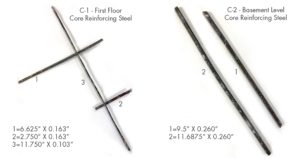Infrastructure Upgrades – Material Verification
MATERIALS LABORATORY CASE STUDY 3
THE PROBLEM
Structural Integrity received several sections of core reinforcing steel from a client performing work at a local university gymnasium (Figure 1). SI’s client needs to have an understanding of the material tensile strength in order to obtain the appropriate replacement material.
THE SOLUTION
Cross-sections were removed from each of the five samples and prepared for hardness testing. The hardness testing was performed as follows:
- Shimadzu Microhardness Tester (HMV-2) –1.961 N load
- Unit calibrated with a 206 Vickers (HV) sample block
- Five readings were made on each sample
The five hardness readings from each sample were averaged and used to estimate the approximate UTS, and the material verification results are provided below.

Figure 1. The core reinforcing steel samples in the as-received condition
|
Sample ID |
Average Hardness (HV) |
Approximate UTS (ksi) |
|
C1-1 |
144.2 |
69 |
|
C1-2 |
147.6 |
70 |
|
C2-1 |
192.2 |
89 |
|
C2-2 |
198.6 |
92 |
|
C2-3 |
169.6 |
79 |
HARDENESS VS. TENSILE STRENGTH
Hardness is a measure of the resistance to localized plastic deformation induced by either mechanical indentation or abrasion, while ultimate tensile strength is the maximum stress that a material can withstand while being stretched or pulled before breaking. Because hardness can often be measured much more readily than tensile strength, it is convenient to use hardness to estimate tensile strength. Hardness correlates linearly to ultimate tensile strength through the empirical (although theoretically explained) equation H=UTS/k. Tensile strength estimates based on hardness should be used for guidance only and should not be used as set reference values. Some material conditions, especially cold work, can change the relationship between the tensile strength and hardness profoundly.
RELATED MATERIALS












